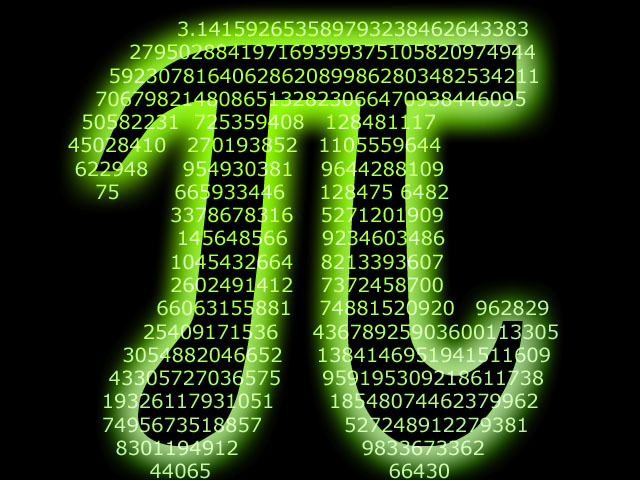
Illustration of the Pi Symbol (Photo: clipart-library.com)
The value of pi (π) is one of the most famous and influential mathematical constants, representing the ratio between the circumference of a circle and its diameter. Pi is an irrational number, meaning it cannot be expressed as a fraction of two integers, and its decimal representation never ends or forms a repeating pattern. In everyday practice, the ratio 22/7 is often used as an approximation for pi, although it is not entirely accurate.
The origin of the use of pi can be traced back to ancient times when early civilizations attempted to understand and calculate the geometry of circles. In Babylonian texts dating back to around 2000 BC, values of pi were used in geometric calculations, although their approach was still rough. For example, they might have used values approximating 3.125 or 3.16 when calculating the circumference of a circle (Beckmann, 1971). One of the earliest systematic records of pi comes from Egypt. In the Rhind Mathematical Papyrus, written around 1650 BC, there is a method for calculating the area of a circle, where Egyptian mathematicians used the value 3.16 as an approximation for pi, indicating that they had a fairly good understanding of the relationship between diameter and circumference.
Earlier and clearer evidence regarding the use of 22/7 as an approximation of pi comes from ancient Greek mathematicians, particularly Archimedes in the 3rd century BC. Archimedes is known for his innovative methods for calculating pi. He employed methods of inscribing and circumscribing polygons to estimate the value of pi. By increasing the number of sides of the polygon used to form a circle, he was able to calculate the circumference of the polygon and approach the value of pi. Archimedes found that pi lies between 3.1408 and 3.1429, thus proposing the use of 22/7 as a practical approximation (Dunham, 1990).
The ratio 22/7 was further popularized by mathematicians across various civilizations. In this context, during the Middle Ages and the Renaissance, 22/7 became a commonly used method in mathematical calculations due to its simplicity. The use of 22/7 also aided in elementary and secondary education, providing an easy way for students to understand the concept of pi without having to use more complex decimal values (Livio, 2005). Although 22/7 is frequently used, it is important to remember that this approximation is not entirely accurate. The value of 22/7 gives approximately 3.142857, while the more precise value of pi is around 3.14159. The difference between these two values, approximately 0.001264, can have significant implications in applications requiring high precision, such as in engineering and physics. Therefore, in more precise applications, it is essential to use a more accurate value of pi.
With the development of technology and mathematical analysis methods, pi has been calculated with very high accuracy. In the 18th century, mathematicians such as Leonhard Euler began using the symbol π to represent this ratio and contributed to the development of more in-depth analytical concepts regarding pi. Johann Lambert in the 18th century also proved that pi is an irrational number, marking an important step in mathematical understanding (Rosen, 2012). In recent decades, with the aid of computers, pi has been calculated to trillions of decimal places. Modern algorithmic methods, as described by Chudnovsky and Chudnovsky (1989), allow researchers to obtain the value of pi with unprecedented speed and accuracy.
Pi has significant applications in many fields, including mathematics, physics, and engineering. In geometry, pi is used to calculate the area and volume of shapes related to circles, such as circles, cylinders, and spheres. In physics, pi appears in various contexts, including in wave equations, relativity theory, and quantum mechanics. The use of the value of pi, both in its rational form of 22/7 and in its more precise decimal form, remains an integral part of various scientific and engineering applications, as well as in more in-depth mathematical analysis.
The origin of the value of pi (π) and the approximation of 22/7 reflect a long journey of mathematical discovery and application, starting from simple measurements in ancient civilizations to sophisticated calculations using modern technology. The value of pi is not just a number; it is a symbol of beauty and complexity in mathematics. With the ongoing advancement of understanding and technology, pi will continue to be one of the most fascinating and important constants in various fields of science.
Keywords: Number, Mathematics, Pi
References
Beckmann, P. (1971). A History of π. Golem Press.
Dunham, W. (1990). The Genius of Euler: Reflections on His Life and Work. Mathematical Association of America.
Livio, M. (2005). The Golden Ratio: The Story of Phi, the World’s Most Astonishing Number. Broadway Books.
Rosen, K. H. (2012). Elementary Number Theory and Its Applications. Academic Press.
Chudnovsky, D., & Chudnovsky, G. (1989). “The computation of classical constants.” Proceedings of the National Academy of Sciences of the United States of America, 86(21), 8178-8182. https://doi.org/10.1073/pnas.86.21.8178.
 Author: Silvina Rosita Yulianti
Author: Silvina Rosita Yulianti
